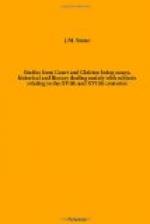In the first year of the King of ric (realm) this Ecgfrith.”
The last line of the inscription is so broken that it can only be guessed at.*
* Cumberland and Westmoreland Antiquarian and Archaeological Society. Bewcastle and its Cross, by W. Nanson, p. 215.
Fine as this obelisk is, we should be at a loss to make out that it was ever a cross, but for a slip of paper which was found in Camden’s own copy of his Britannia (ed. 1607 now in the Bodleian Library. On the slip of paper was written this memorandum: “I received this morning a ston from my lord of Arundel, sent him from my lord William. It was the head of a cross at Bucastle: and the letters legable are these on one line, and I have sett to them such as I can gather out of my alphabetts: that like an A I can find in non. But wither this may be only letters or words I somewhat doubt.”
Neither Camden nor any one else got much further than this for many years; and the general ignorance of runes is the more to be deplored since it led to a carelessness and want of interest in the preservation of priceless relics, even among antiquaries. The stone which thus came into Camden’s possession has utterly disappeared, and the inscription which he tried in vain to decipher, and which might have thrown light on a mysterious subject, is thus lost to us.
In conclusion, we may, for the sake of clearness, recapitulate, first: that although there can no longer be any reasonable doubt that the runes on the Ruthwell obelisk are by the Northumbrian poet, Cynewulf, it has by no means been satisfactorily proved that these runes are of a subsequent date to the West-Saxon version of the poem in the Vercelli Codex, but that probability seems rather to point to an earlier date than the second half of the tenth century; and secondly, that so close a resemblance between the two Crosses does not necessarily imply that they date from absolutely the same period. The royal obelisk at Bewcastle must have been a famous monument in its day, known and celebrated far and wide, and it would not be unlikely that even a hundred years later it might be called upon to serve, to some extent, as a model for that Cross which was to immortalise the Dream of which Northumbrians were naturally proud. If, however, the runes on the Bewcastle Cross fix its date as the latter part of the seventh century, those on the Ruthwell Cross cannot be earlier than the eighth century.
Had the zeal, directed nearly four hundred years ago against our national treasures, been bestowed on their preservation, we should have reason indeed to congratulate ourselves on the beauty of many of our public monuments. Instead of mutilated remains, we should have works of art which, but for the gentle hand of time, would be as perfect as when they left the master’s hand.
But there has never been a period when the intelligent study of the past, whether in palaeography, philology, or history, has been so highly cultivated as in the present day. If we have lost the inspiration that creates, we have, at least, learned to venerate and cherish the noble works of our progenitors.




